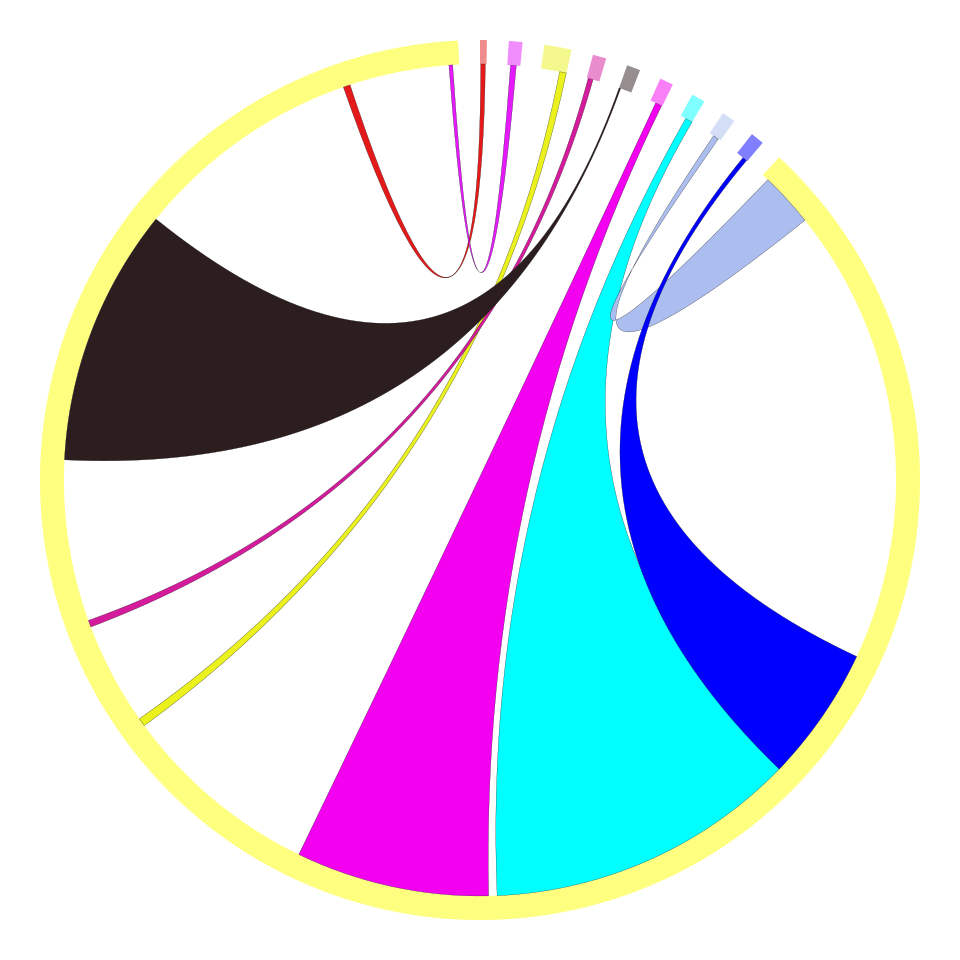Visualize relationships or network flow with an aesthetically-pleasing circular layout. A fork from d3-chord that enables the user to construct chords from objects and freedom to specify a starting and ending positions for each chord.
If you use NPM, npm install d3-chord. Otherwise, download the latest release. AMD, CommonJS, and vanilla environments are supported. In vanilla, a d3 global is exported:
<script src="https://d3js.org/d3-array.v1.min.js"></script>
<script src="https://d3js.org/d3-path.v1.min.js"></script>
<script src="d3-chord.v1.min.js"></script>
<script>
var chord = d3.chord();
</script>Constructs a new chord layout with the default settings.
Computes the chord layout for the specified object, where the object represents the directed connections between the different groups specified in meta. The given object must be an array, where each element object[i] is an object with origin, target, origin_start, origin_end, target_start, target_end, where each object.origin represents the name of the origin group, object.target is the name of the target group. origin_start, origin_end represent the start and end of this connection in the origin node, target_start, target_end are the start and end of this connection in the target node. The start and end must be contained in size of the node. Example:
var object = [
{origin: "tig00007144", target: "chr03", origin_start: 113, origin_end: 824, target_start: 332034, target_end: 333111},
{origin: "tig00026480", target: "chr03", origin_start: 500, origin_end: 1387, target_start: 348621, target_end: 349199},
{origin: "tig00003221", target: "chr03", origin_start: 2916, origin_end: 3961, target_start: 212786, target_end: 214087},
{origin: "tig00010111", target: "chr03", origin_start: 218, origin_end: 989, target_start: 230067, target_end: 231135},
{origin: "tig00000318", target: "chr03", origin_start: 1, origin_end: 244, target_start: 256211, target_end: 296393},
{origin: "tig00009327", target: "chr03", origin_start: 878, origin_end: 1878, target_start: 141515, target_end: 161602},
{origin: "tig00025208", target: "chr03", origin_start: 878, origin_end: 2000, target_start: 100069, target_end: 150203},
{origin: "tig00019172", target: "chr03", origin_start: 720, origin_end: 1583, target_start: 1066, target_end: 9500},
{origin: "tig00004923", target: "chr03", origin_start: 1154, origin_end: 1849, target_start: 100531, target_end: 161598}
];
var meta = [
{name: "tig00007144", size: 1000},
{name: "tig00026480", size: 2000},
{name: "tig00003221", size: 4000},
{name: "tig00010111", size: 2000},
{name: "tig00000318", size: 2000},
{name: "tig00009327", size: 2000},
{name: "tig00025208", size: 2000},
{name: "tig00019172", size: 2000},
{name: "tig00004923", size: 2000},
{name: "chr03" , size: 350204}
]The return value of chord(object, meta) is an array of chords, where each chord represents the combined bidirectional flow between two nodes i and j (where i may be equal to j) and is an object with the following properties:
source- the source subgrouptarget- the target subgroup
Each source and target subgroup is also an object with the following properties:
startAngle- the start angle in radiansendAngle- the end angle in radiansvalue- the flow valueindex- the node index isubindex- the node index j
The chords are typically passed to d3.ribbon to display the network relationships. The returned array includes only chord objects for which the value is non-zero. In other words, chord.source.index equals chord.target.subindex, chord.source.subindex equals chord.target.index, chord.source.value and chord.target.value can be different, and are always greater than zero.
The chords array also defines a secondary array of length n, chords.groups, where each group is an object with the following properties:
startAngle- the start angle in radiansendAngle- the end angle in radiansvalue- the total size for node iindex- the node index i
The groups are typically passed to d3.arc to produce a donut chart around the circumference of the chord layout.
If angle is specified, sets the pad angle between adjacent groups to the specified number in radians and returns this chord layout. If angle is not specified, returns the current pad angle, which defaults to zero.
# chord.sortGroups([compare]) <>
If compare is specified, sets the group comparator to the specified function or null and returns this chord layout. If compare is not specified, returns the current group comparator, which defaults to null. If the group comparator is non-null, it is used to sort the groups by their total outflow. See also d3.ascending and d3.descending.
Creates a new ribbon generator with the default settings.
Generates a ribbon for the given arguments. The arguments are arbitrary; they are simply propagated to the ribbon generator’s accessor functions along with the this object. For example, with the default settings, a chord object expected:
var ribbon = d3.ribbon();
ribbon({
source: {startAngle: 0.7524114, endAngle: 1.1212972, radius: 240},
target: {startAngle: 1.8617078, endAngle: 1.9842927, radius: 240}
}); // "M164.0162810494058,-175.21032946354026A240,240,0,0,1,216.1595644740915,-104.28347273835429Q0,0,229.9158815306728,68.8381247563705A240,240,0,0,1,219.77316791012538,96.43523560788266Q0,0,164.0162810494058,-175.21032946354026Z"Or equivalently if the radius is instead defined as a constant:
var ribbon = d3.ribbon()
.radius(240);
ribbon({
source: {startAngle: 0.7524114, endAngle: 1.1212972},
target: {startAngle: 1.8617078, endAngle: 1.9842927}
}); // "M164.0162810494058,-175.21032946354026A240,240,0,0,1,216.1595644740915,-104.28347273835429Q0,0,229.9158815306728,68.8381247563705A240,240,0,0,1,219.77316791012538,96.43523560788266Q0,0,164.0162810494058,-175.21032946354026Z"If the ribbon generator has a context, then the ribbon is rendered to this context as a sequence of path method calls and this function returns void. Otherwise, a path data string is returned.
If source is specified, sets the source accessor to the specified function and returns this ribbon generator. If source is not specified, returns the current source accessor, which defaults to:
function source(d) {
return d.source;
}If target is specified, sets the target accessor to the specified function and returns this ribbon generator. If target is not specified, returns the current target accessor, which defaults to:
function target(d) {
return d.target;
}If radius is specified, sets the radius accessor to the specified function and returns this ribbon generator. If radius is not specified, returns the current radius accessor, which defaults to:
function radius(d) {
return d.radius;
}# ribbon.startAngle([angle]) <>
If angle is specified, sets the start angle accessor to the specified function and returns this ribbon generator. If angle is not specified, returns the current start angle accessor, which defaults to:
function startAngle(d) {
return d.startAngle;
}The angle is specified in radians, with 0 at -y (12 o’clock) and positive angles proceeding clockwise.
If angle is specified, sets the end angle accessor to the specified function and returns this ribbon generator. If angle is not specified, returns the current end angle accessor, which defaults to:
function endAngle(d) {
return d.endAngle;
}The angle is specified in radians, with 0 at -y (12 o’clock) and positive angles proceeding clockwise.
# ribbon.context([context]) <>
If context is specified, sets the context and returns this ribbon generator. If context is not specified, returns the current context, which defaults to null. If the context is not null, then the generated ribbon is rendered to this context as a sequence of path method calls. Otherwise, a path data string representing the generated ribbon is returned. See also d3-path.

